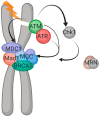How Cells Handle DNA Breaks during Mitosis: Detection, Signaling, Repair, and Fate Choice
- PMID: 31500247
- PMCID: PMC6770852
- DOI: 10.3390/cells8091049
How Cells Handle DNA Breaks during Mitosis: Detection, Signaling, Repair, and Fate Choice
Abstract
Mitosis is controlled by a complex series of signaling pathways but mitotic control following DNA damage remains poorly understood. Effective DNA damage sensing and repair is integral to survival but is largely thought to occur primarily in interphase and be repressed during mitosis due to the risk of telomere fusion. There is, however, increasing evidence to suggest tight control of mitotic progression in the incidence of DNA damage, whether induced in mitotic cells or having progressed from failed interphase checkpoints. Here we will discuss what is known to date about signaling pathways controlling mitotic progression and resulting cell fate in the incidence of mitotic DNA damage.
Keywords: DNA damage; DNA repair; cancer; cell fate; mitosis.
Conflict of interest statement
The authors declare no conflicts of interest.
Figures



References
Publication types
MeSH terms
Substances
Grants and funding
LinkOut - more resources
Full Text Sources

